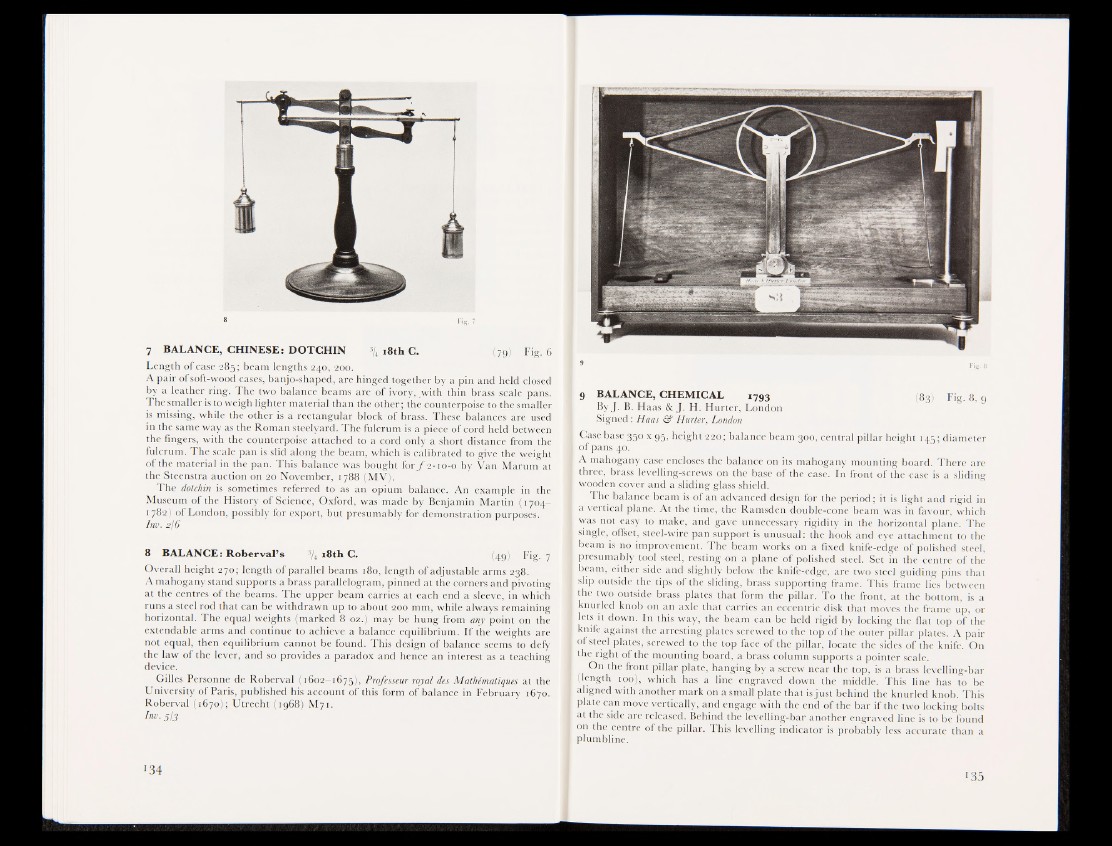
7 BALANCE, CHINESE: DOTCHIN ^ 18th C. Fig. 6
Length of case 285; beam lengths 240, 200.
A pair of soft-wood cases, banjo-shaped, are hinged together by a pin and held closed
by a leather ring. The two balance beams are of ivory, with thin brass scale pans.
The smaller is to weigh lighter material than the other;; the counterpoise to the smaller
is missing, while the other is a rectangular block of brass. These balances are used
in the same way as the Roman steelyard. The fulcrum is a piece of cord held between
the fingers, with the counterpoise attached to a cord only a short distance from the
fulcrum. The scale pan is slid along the beam, which is calibrated to give the weight
of the material in the pan. This balance was bought for ƒ 2-10-0 by Van Marum at
the Steenstra auction on 20 November, 1788 (MV).
The dotchin is sometimes referred to as an opium balance. An example in the
Museum of the History of Science, Oxford, was made by Benjamin Martin (1704-
1782) of London, possibly for export, but presumably for demonstration purposes,
Inv. 2/6
8 BALANCE: Roberval’ s 3/4 18th C. (49SÉ Fig.
Overall height 270; length of parallel beams 180, length of adjustable arms 238.
A mahogany stand supports a brass parallelogram, pinned at the jirners and pivoting
at the centres of the beams. The upper beam carries at each end a sleeve, in which
runs a steel rod that can be withdrawn up to about 200 mm, while always remaining
horizontal. The equal weights (marked 8 oz.ljmay be hung from any point on the
extendable arms and continue to achieve a balance equilibrium. If the weights; are
not equal, then equilibrium cannot be found. This design of balance seems to defy
the law of the lever, and so provides a paradox and hence an interest as a teaching
device.
Gilles Personne de Roberval ( 1602-16y^MProfesseur royal des Mathématiques at the
University of Paris, published his account of this form of balance in February 1670.
Roberval (1670); Utrecht (1968) M71.
Inv. 5I3
9 Fig. 8
9 BALANCE, CHEMICAL 1793 (83) Fig. 8, 9
ByJ. B. Haas & J. H. Hurter, London
Signed : Haas & Hurter, London
Case base 330 x 95, height 220; balance beam 300, central pillar height 145; diameter
of pans 40.
A mahogany case encloses the balance on its mahogany mounting board. There are
three, brass levelling-screws on the base of the case. In front of the case is a sliding
wooden cover and a sliding glass shield,
The balance beam is of an advanced design for the period j it is light and rigid in
a vertical plane. At the time, the Ramsden double-cone beam .was in favour, which
was not easy to make, and gave unnecessary rigidity in the horizontal plane. The
single, offset, steel-wire pan support is unusual: the hook and eye attachment to the
beam is no improvement. The beam works on a fixed knife-edge of polished steel,
presumably tool steel, resting on a plane of polished steel. Set in the centre of the
beam, either side and slightly below the knife-edge, are two steel guiding pins that
slip outside the tips of the sliding,, brass supporting frame. This frame lies between
the two outside brass plates that form the pillar. To the front, at the bottom, is a
knurled knob on an axle that carries an eccentric disk that moves the frame up, or
lets it down. In this way, the beam can be held rigid by locking the flat top of the
knife against the arresting plates screwed to the top of the outer pillar plates. A pair
of steel plates, screwed to the top face of the pillar, locate the sides of the knife. On
the right of the mounting board, a brass column supports a pointer scale.
On the front pillar plate, hanging by a screw near the top, is a brass levelling-bar
(length 100), which has a line engraved down the middle. This line has to be
aligned with another mark on a small plate that is just behind the knurled knob. This
plate can move vertically, and engage with the end of the bar if the two locking bolts
at the side are released. Behind the levelling-bar another engraved line is to be found
on the centre of the pillar. This levelling indicator is probably less accurate than a
plumbline.